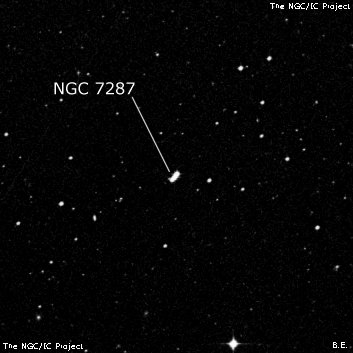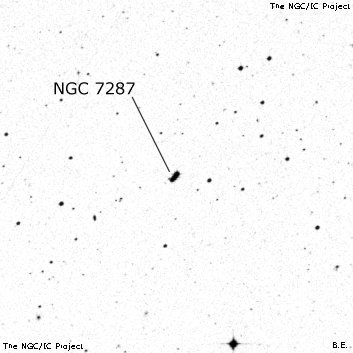NGC/IC Project Restoration Effort
(This is a very very beta version)
NGC7287


Basic Information
Location and Magnitude
Right Ascension: 22:28:32.0
Declination: -22:8:0
Constellation: AQR
Visual Magnitude:
Historic Information
Discoverer: Muller
Year of discovery: 1886
Discovery aperture: 26.3
Observational
Summary description: eF, slightly nebs D *
Sub-type: *2
Corwin's Notes
=====
NGC 7287 may be the double star listed in the main table. This is Howe's
identification for an object found by Frank Muller with the 26-inch refractor
at Leander McCormick. His description fits Muller's except for the magnitude:
Muller makes his object 15.0, while Howe puts his at 11.5 + 11.5 for a total
of 10.7! The position angles are the same, though: 150 deg (Muller runs it
on around the circle to 330 deg), as are the separations at 6 arcsec.
On the DSS, Howe's "double" is actually a triple in a line at PA = 145 deg,
with the largest separation being about 12-13 arcsec. The magnitude, as
nearly as I can judge it, is about half way between the two earlier estimates.
So, this could well be Muller's object.
However, Dreyer has an interesting note in IC2: "Ho[we] says that the RA is
about 2 minutes too great, and that the object is only a F D*, dist 6 arcsec.
But he must have found a different object, as Burnham (Lick Obs, ii, p. 180)
[which I have not seen] without noticing any great error in RA, gives Pos 60
deg, Dist 20 arcsec, and states that the p one is undoubtedly a nebula, while
the f one may be a star."
Muller's published position falls in group of galaxies, one of which is a
pair with a star nearby roughly in the configuration noted by Burnham. I've
included this in the main table, too, as it may be Burnham's object. This,
too, could have been the object seen by Muller -- his telescope was certainly
big enough to pull in the photons.
But with Howe's stars being brighter, near the 2 minute RA offset shared by
several other of the Leander McCormick nebulae, and with their sharing the
correct description with Muller's original observation, I'm more inclined
toward them. Hence, they have only one query in the table, while the galaxies
and star that Burnham may have seen have two question marks.
Steve's Notes
=====
NGC 7287
18" (8/31/11): this close pair of stars (seems to be a trio of stars on the DSS) was barely resolved at 220x and initially could have easily passed for a small, nebulous object, elongated NW-SE. The separation is just a few arc seconds. Located 21' WSW of 7.4-magnitude HD 213005.
The NGC position happens to fall closer to ESO 602-020 = PGC 68960 (double system), which is identified as NGC 7287 in NED, although this galaxy is less likely to be the NGC object. ESO 602-020 appeared very faint, small, slightly elongated, bright core.



